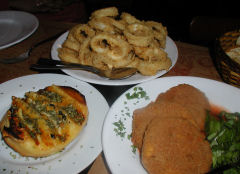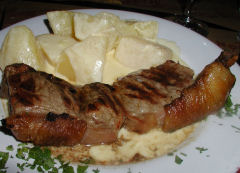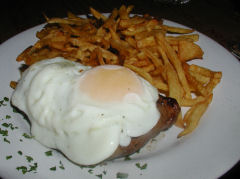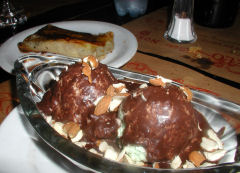Buenos Aires – José Andrés Pacheco de Melo was alive, here in Argentina, at one time. I’m reasonably certain of that. He was a priest, born in the northern city Salta, though I’m guessing he wasn’t a priest at birth. Later on he became a deputy of the national congress, and, was one of the signers of the Declaration of Independence. There is some difference of opinion in various biographies as to when he was born and when he died, the former being around 1768-1779, an eleven year range, which is a pretty big discrepancy, and the latter claiming his death either in 1820 or “after 1825”. I’m inclined to believe the later fuzzy date, since there seems to be a fair amount of evidence that he was active in mediating several government disputes in 1821 and 1825, post-independence. Regardless, he has a street named after him here in Barrio Norte, Pacheco de Melo, and on that street, at number 1833 (maybe THAT was the year he died…) is the restaurant, Melo.
Our friends Jerry and Czar are back from a cruise around the Cape, and, unfortunately only here for a few days until they head back to Canada, where they seem to think it’s important to live for half the year or more. Henry is still a little under the weather, so he didn’t join us for dinner. We started the evening at home, popping a bottle of Dragani Selva de’ Canonici Montepulciano d’Abruzzo 1999, a good, medium bodied, and fairly rustic style Montepulciano that I had in the cellar. Afterwards the three of us wandered down to the restaurant, which the two of them had asserted had among the better steaks they’ve had in Buenos Aires this trip.
 Melo is not a large place, seating maybe 40-50 people, and is done up in a lot of exposed brick, and deep red painted walls. The “artwork” is mostly semi-ornately framed mirrors scattered throughout the room, mostly well above eye level, so they don’t add any dimension of space, but are an interesting touch. The waiters are friendly and cheerful, and, at least based on the physique and the regular murmurs of “oh yes, that’s one of my favorites” (in Spanish of course) of the three who were there last night, enjoy eating… The menu is pretty classic porteña, with the usual salads, pastas, and grill sections. We decided to start with a trio of cholesterol bombs, a provoleta – good, but a bit chewy, and perhaps a touch too much oregano; milanesa de mozzarella – better, and pretty decent breading, and the fresh basil salad was a nice touch; and rabas a la provencal – which were not a la provencal at all, but plain fried (provencal being with garlic and parsley), still, good, served with lemon, though we asked for some salsa picante, which took a few minutes, but turned out to be a nicely made bowl of freshly chopped tomato, onion, and chili.
Melo is not a large place, seating maybe 40-50 people, and is done up in a lot of exposed brick, and deep red painted walls. The “artwork” is mostly semi-ornately framed mirrors scattered throughout the room, mostly well above eye level, so they don’t add any dimension of space, but are an interesting touch. The waiters are friendly and cheerful, and, at least based on the physique and the regular murmurs of “oh yes, that’s one of my favorites” (in Spanish of course) of the three who were there last night, enjoy eating… The menu is pretty classic porteña, with the usual salads, pastas, and grill sections. We decided to start with a trio of cholesterol bombs, a provoleta – good, but a bit chewy, and perhaps a touch too much oregano; milanesa de mozzarella – better, and pretty decent breading, and the fresh basil salad was a nice touch; and rabas a la provencal – which were not a la provencal at all, but plain fried (provencal being with garlic and parsley), still, good, served with lemon, though we asked for some salsa picante, which took a few minutes, but turned out to be a nicely made bowl of freshly chopped tomato, onion, and chili.
 I haven’t seen a listing on a menu here that just said “Baby Beef”, so I was curious. Our waiter, informing me that it was one of his favorites, said it was a bife de chorizo, or more or less the same as a New York strip steak, but from a younger cow, very tender, very rich, very delicious. It was quite good, and one of the better I’ve had. It also wasn’t a monster sized portion of steak, which I appreciated, since I hate to leave half a steak on my plate, and I know that if I take it home and put it in the refrigerator it runs a good chance of staying there until it becomes a science fair project. It was served with papas a la crema, which in this case were large chunks of potato topped with a decent cream sauce – I have to admit I’m more fond of the version with the potatoes sliced very thin and cooked in the cream.
I haven’t seen a listing on a menu here that just said “Baby Beef”, so I was curious. Our waiter, informing me that it was one of his favorites, said it was a bife de chorizo, or more or less the same as a New York strip steak, but from a younger cow, very tender, very rich, very delicious. It was quite good, and one of the better I’ve had. It also wasn’t a monster sized portion of steak, which I appreciated, since I hate to leave half a steak on my plate, and I know that if I take it home and put it in the refrigerator it runs a good chance of staying there until it becomes a science fair project. It was served with papas a la crema, which in this case were large chunks of potato topped with a decent cream sauce – I have to admit I’m more fond of the version with the potatoes sliced very thin and cooked in the cream.
 Melo also offers lomo, or sirloin, in a “medio”, or half portion, which is good, because a full sirloin here can be a monster to tackle. Both of my dining companions ordered a medio lomo (another favorite of our waiter), topped with a fried egg, and accompanied by “papas pataille”, which seems to be what Melo calls what is usually here referred to as papas pay, or very thin french fries – a strange term, the former, since pataille is relatively common French surname, but doesn’t, as far as I know, mean anything in particular. I’ll have to pop back one day and look to see if I’ve misremembered the name, but I do recall noting it as being rather a strange nomenclature. Washed all of this varied and sundry down with a lovely bottle of 2005 Bodegas Salentein’s Finca El Portillo Malbec.
Melo also offers lomo, or sirloin, in a “medio”, or half portion, which is good, because a full sirloin here can be a monster to tackle. Both of my dining companions ordered a medio lomo (another favorite of our waiter), topped with a fried egg, and accompanied by “papas pataille”, which seems to be what Melo calls what is usually here referred to as papas pay, or very thin french fries – a strange term, the former, since pataille is relatively common French surname, but doesn’t, as far as I know, mean anything in particular. I’ll have to pop back one day and look to see if I’ve misremembered the name, but I do recall noting it as being rather a strange nomenclature. Washed all of this varied and sundry down with a lovely bottle of 2005 Bodegas Salentein’s Finca El Portillo Malbec.
 Dessert time came, and although stuffed, we toughed it out. In the background, a panqueque de dulce de leche, not bad, but not great – the dulce de leche a trifle overcooked, giving it just a hint of a burnt flavor. The Postre Harry, in the forefront, was far better – two scoops of mint chocolate chip gelato, coated in chocolate sauce, atop a couple of chocolate cookies, and the whole thing drenched in cocoa syrup and almonds. Both desserts, favorites of our waiter, though he admitted he preferred to substitute plain cream flavored gelato for the mint chocolate chip. We never did find out who Harry is.
Dessert time came, and although stuffed, we toughed it out. In the background, a panqueque de dulce de leche, not bad, but not great – the dulce de leche a trifle overcooked, giving it just a hint of a burnt flavor. The Postre Harry, in the forefront, was far better – two scoops of mint chocolate chip gelato, coated in chocolate sauce, atop a couple of chocolate cookies, and the whole thing drenched in cocoa syrup and almonds. Both desserts, favorites of our waiter, though he admitted he preferred to substitute plain cream flavored gelato for the mint chocolate chip. We never did find out who Harry is.
What in the name of Julia Child is Argentina’s thing with fried eggs!? It seems they like them on top of everything. Oh yes, it’s one of my favorites.
I really don’t know where that comes from, it’s obviously not part of the dominant Italian background of the culture, nor Spanish or Portuguese. I understand it on milanesas – common enough on something in Europe like a Wiener Schnitzel, which is in essence the same thing; but why it has gone on being an option for many steaks, I don’t know. On the other hand, maybe it’s not – it wasn’t a listed option on the menu (where it was part of a different dish), it was a request of my two dining companions, and they’re from Canada. I have no sense of whether or not it’s Argentines who order this regularly or more tourists and expats from one place or another.
Hold on a moment. Your friends asked for the eggs and they’re from Canada? I have my explanation. Ay?
papas pataille = papas paille?
Had them a few times but with how lard/oil heavy most papas are at restaurants that style takes it to another level. I think the translation is oil with a touch of potato. I’ll usually tell the waiter to subsitute them for rejillas.
They were indeed more or less papas paille/pay, but not quite as crispy, which may be the house style. I was just more intrigued by the use of a French term connected to the Spanish, especially when the French one doesn’t have any culinary connotation that I know of.
Dan,
The translation of “paille” into Castilian is “paja”. But paja has another meaning besides “straw” that is socially unacceptable.
Also, never ask for “choto” in Buenos Aires. It will be very embarassing.
Gustavo
[…] for one. It was fine, it had its pluses, but overall, there are better steakhouses in the area (Melo and Clark’s standout nearby), and even better ones a short trip […]